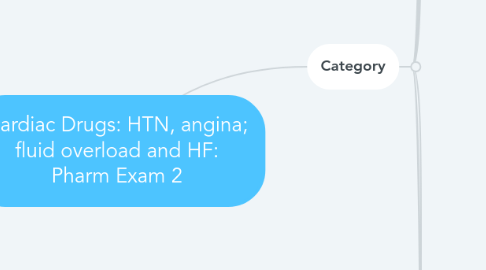
1. Category
1.1. adrenergic
1.1.1. alpha agonist (alpha 2)
1.1.1.1. decrease sympathetic nervous activity, norepinephrine production, and renin activity
1.1.1.1.1. clonidine
1.1.1.1.2. methyldopa
1.1.2. alpha blocker (alpha 1)
1.1.2.1. dilates arteries and veins; increase urinary flow rate; decrease bladder neck and urethral obstruction
1.1.2.1.1. doxazOSIN
1.1.2.1.2. prazOSIN
1.1.2.1.3. terazOSIN
1.1.2.1.4. tamsulOSIN
1.1.3. beta blocker
1.1.3.1. reduces HR and BP by blocking SNS; reduces renin secretion;
1.1.3.1.1. metoproLOL
1.1.3.1.2. carvediLOL
1.1.3.1.3. propanoLOL
1.1.3.2. side effects
1.1.3.2.1. cardiac
1.1.3.2.2. metabolic
1.1.3.2.3. CNS
1.1.3.2.4. Other
1.1.3.3. contraindications
1.1.3.3.1. acute HF; dysrhythmias; asthma; DM; vascular disease
1.1.3.3.2. DON'T use labetaLOL (HTN) or carvediLOL (HF) dually with ASTHMA
1.1.3.4. nursing implications
1.1.3.4.1. monitor HR <60; report dizzy/fainting; not for long term angina
1.1.4. Side Effects of adrenergic antagonist and blockers
1.1.4.1. orthostatic hypotension; palpitations; sexual dysfunction; vertigo; dry mouth; constipation; n/v
1.1.5. Nursing Implications
1.1.5.1. thorough Hx; v/s; allergy; drug interaction; contraindications; OTC drugs; limit CAFFEINE; orthostasis; ETOH; hot water/conditions
1.2. ACE inhibitors
1.2.1. uses renin-angiotensin aldosterone (RAA) system to treat HTN and HF
1.2.1.1. Why this lowers BP
1.2.1.1.1. prevents breakdown of bradykinin (vasodilator)
1.2.1.1.2. prevents angiotensin II from causing vasoconstriciton
1.2.1.1.3. prevents Na and H2O resorption to reduce preload/BP thus afterload of LV
1.2.2. TERATOGENIC
1.2.3. drug of choice for early HF; Second-line tx for HTN (1st-diuretic); CCB added for uncontrolled HTN
1.2.3.1. lisinoPRIL
1.2.3.1.1. NOT a prodrug
1.2.3.2. captoPRIL
1.2.3.2.1. NOT a produg
1.2.3.3. enalaPRIL
1.2.3.3.1. prodrug
1.2.3.4. ramiPRIL
1.2.3.4.1. prodrug
1.2.4. Cardioprotective/Renal protective
1.2.4.1. BUT do NOT give with renal damage
1.2.5. SIDE EFFECTS
1.2.5.1. fatigue; dizzy; headache; mood change; impaired taste; possible hyperkalemia
1.2.5.2. dry, unproductive ACE COUGH
1.2.5.2.1. use ARBs if cough occurs
1.2.5.3. angioedema
1.2.6. RN implications
1.2.6.1. Cr and K+ labs
1.3. ARBs
1.3.1. Tx for HTN and HF when ACE inhibitor causes cough
1.3.1.1. loSARTAN
1.3.1.2. valSARTAN
1.3.1.3. irbeSARTAN
1.3.1.4. candeSARTAN
1.3.2. Blocks A-II receptors; stops vasoconstriction and release of aldosterone
1.3.3. TERATOGENIC
1.3.4. used alone or with diuretics
1.3.5. SIDE EFFECTS
1.3.5.1. Dizzy; fatigue; hypoglycemia; diarrhea; UTI; anemia; weakness
1.4. Calcium channel blockers
1.4.1. angina; HTN; dysrhythmias; migraines, Raynaud's
1.4.1.1. amloDIPINE
1.4.1.2. nicarDIPINE
1.4.1.3. nifeDIPINE
1.4.1.4. verapamil
1.4.1.4.1. not used often
1.4.1.5. diltiazem
1.4.1.5.1. dysrhythmias
1.4.2. CONTRAINDICATIONS
1.4.2.1. allergies; acute MI; hypotension; bradycardia
1.4.3. SIDE EFFECTS
1.4.3.1. overexpression of therapeutic effects
1.4.3.1.1. hypotension; palpitations; bradycardia; constipation; n/v; dyspnea
1.5. direct renin inhibitors
1.5.1. CONTRAINDICATIONS
1.5.1.1. in combo with ACE/ARBs in pts with DM or renal impairment
1.5.1.1.1. can cause renal impairment, hyperkalemia; severe hypoTN
1.5.2. treat HTN by vasodilation
1.5.2.1. aliskiREN
1.6. diuretics
1.6.1. accelerate rate of urine formation causing removal of Na and H2O
1.6.2. Tx for HTN and HF
1.6.3. RN implications for diuretics
1.6.3.1. fluid volume; I&Os; daily wt; v/s
1.6.3.2. assess contraindications and toxicities (digoxin)
1.6.3.3. take in morning to avoid sleep disturbances
1.6.3.4. monitor K+
1.6.3.4.1. hypo with most
1.6.3.4.2. hyper with K+ sparing
1.6.3.5. Teach
1.6.3.5.1. nutrition (K+)
1.6.3.5.2. Ortho hypoTN
1.6.3.6. notify PCP
1.6.3.6.1. Increased HR or syncope
1.6.3.7. monitor side effects and therapeutic effects
1.6.4. Types of diuretics
1.6.4.1. loop diuretics
1.6.4.1.1. used for HF edema to control HTN
1.6.4.1.2. causes potent diuresis and fluid loss
1.6.4.1.3. SIDE EFFECTS
1.6.4.1.4. Interactions
1.6.4.2. potassium sparing diuretics/aldosterone antagonist
1.6.4.2.1. block aldosterone receptors and inhibit action; block resorption of Na and H2O; prevent K+ from being pumped into tubule
1.6.4.2.2. Tx HTN and HF
1.6.4.2.3. SIDE EFFECTS
1.6.4.2.4. Interactions
1.6.4.3. thiazide diuretics
1.6.4.3.1. first-line for HTN; edema; kidney stones; diabetes insipidus; HF
1.6.4.3.2. inhibits tubular resorption of Na+, Cl-, K+ resulting in ion loss with water loss; dilate arterioles by direct relaxation
1.6.4.3.3. SIDE EFFECTS
1.6.4.4. osmotic diuretics
1.6.4.5. carbonic anhydrase inhibitors
1.7. vasodilators
1.7.1. Tx HTN by vasodilation and decreased afterload (SVR) to decrease BP
1.7.1.1. diazoxide
1.7.1.1.1. HTN emergency Tx
1.7.1.2. nitroprusside
1.7.1.2.1. HTN emergency Tx
1.7.1.2.2. SIDE EFFECTS
1.7.1.3. minoxidil
1.7.1.3.1. also hair growth
1.7.1.3.2. SIDE EFFECTS
1.7.1.4. hydralazine
1.7.1.4.1. SIDE EFFECTS
1.7.2. Tx pulmonary HTN
1.7.2.1. bosentan
1.7.2.1.1. blocks endothelin receptors
1.7.2.1.2. most common and only for pulmonary HTN
1.7.2.2. epoprostenol
1.7.2.2.1. continuous IV infusion
1.7.2.3. treprostinil
1.7.2.3.1. also antiplatelet
1.7.2.4. sildenafil
1.7.2.4.1. viagra
1.7.2.4.2. tadalafil
1.8. nitrates
1.8.1. for angina; causes vasodilation in coronary arteries; increased O2 to myocardial tissue
1.8.1.1. nitroglycerin
1.8.1.1.1. prototypical nitrate for angina
1.8.1.1.2. sublingual, IV, transdermal, and ointments
1.8.1.2. isosorbide dinitrate/mononitrate
1.8.1.2.1. organic nitrate for angina
1.8.1.2.2. immediate release tablets and long acting oral dosage forms
1.8.2. CONTRAINDICATIONS
1.8.2.1. allergy; anemia; glaucoma; hypoTN; head injury; use of Erectile Dysfunction (ED) drugs (sildenAFIL, tadalAFIL, and vardedAFIL)
1.8.3. SIDE EFFECTS
1.8.3.1. headaches (usually decrease with continued use)
1.8.3.2. reflex tachycardia; postural hypoTN
1.8.4. Pt Education
1.8.4.1. proper technique (5 min for sublingual before swallow/take off topical at night)
1.8.4.2. store in airtight, dark glass bottle with metal cap and no cotton filler
1.8.4.3. take at first hint of angina
1.8.4.4. monitor v/s frequently
1.8.4.5. lie down to prevent dizzy

